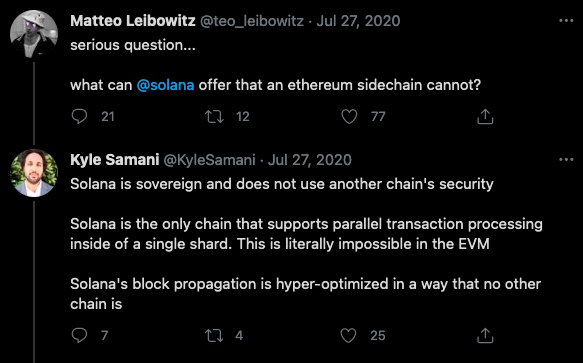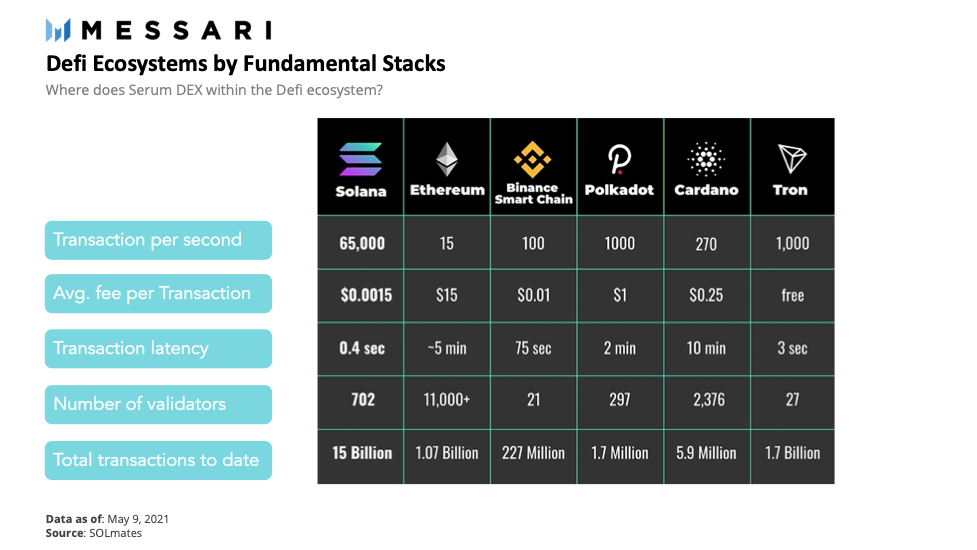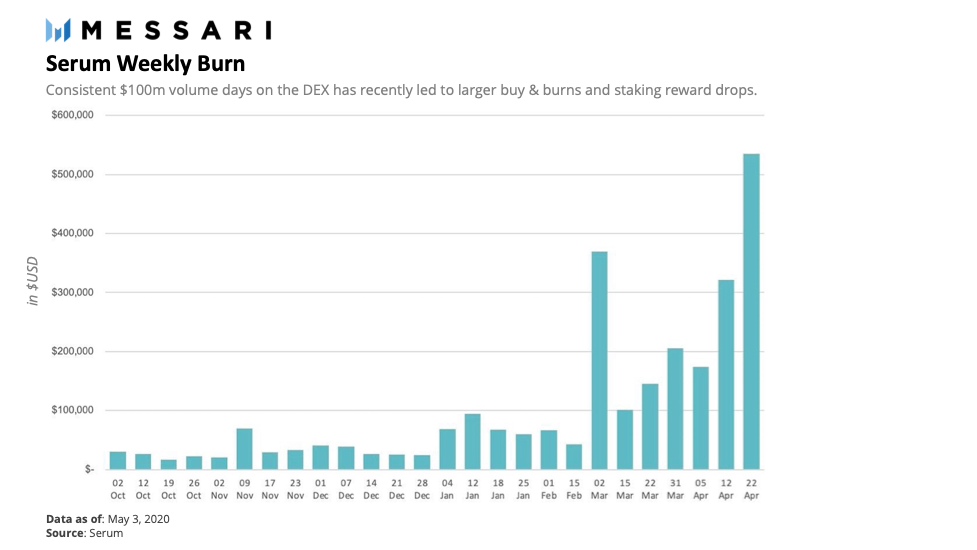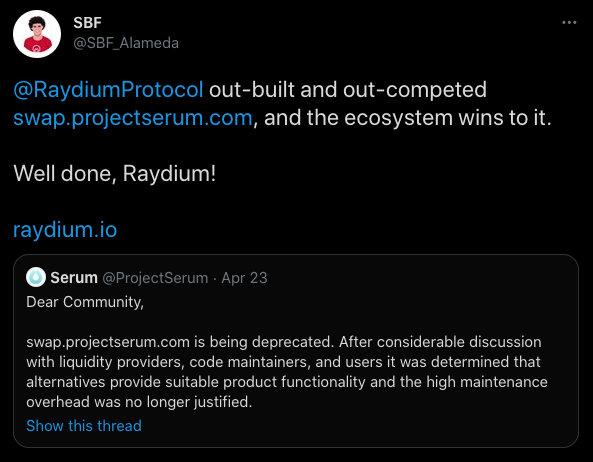An Overview of the Solana-Based Decentralized Exchange Serum
Author: Oguz Genc, messari
Compiled by: DeFi Dao
Serum is a bold attempt to provide an alternative DeFi infrastructure that allows applications to focus on growth without worrying about traditional layer 1 issues, especially the "scalability trilemma." At its core, Serum is a decentralized exchange (DEX), but more broadly, it can be seen as an ecosystem that brings high speed and low transaction costs to decentralized finance.
Since the rise of DeFi last summer, the operational demand on Ethereum has surged. With the price of ETH rising, Ethereum Gas fees have once again become a focal point, especially during the market crash on May 19. However, despite astronomical growth in DeFi TVL, the lack of scalability in Ethereum's base layer is preventing DeFi from becoming a trillion-dollar industry.
The Serum project launched during the DeFi summer of 2020, aiming to address this scalability challenge by establishing a new decentralized exchange based on Solana.
It is understood that Serum DEX features a centralized limit order book model, aiming to bring the high-quality trading experience of CeFi into DeFi. Serum is built on Solana, which employs a novel approach to scaling and reducing network fees while maintaining security, decentralization, permissionlessness, and censorship resistance.
Solana ensures composability by maintaining a single global state among ecosystem projects. This provides the ability to build custom products without having to switch between different protocols for executing trades. Without worrying about integration with multiple shards or second-layer solutions, Solana allows applications to focus on execution.


Source: Kyle Samani
Additionally, Solana boasts extremely fast speeds, with a 400 millisecond block time and sub-second finality. With a network throughput of 65,000 TPS, Solana validators can manage the network with almost no memory pool, making Solana one of the most performant blockchains in the world. Solana built a live demonstration to showcase how easily Ethereum and Bitcoin blockchains can become congested compared to Solana.


Source: Break Solana
The scalability and composability of Solana benefit from its ability to provide low transaction costs. With transaction fees as low as $0.00001, Serum can offer the most cost-effective trading experience across any DEX.
To provide a better perspective, the following chart offers a more comprehensive comparison of Solana and other layer ones in terms of TPS, latency, cost per transaction, and number of validators, highlighting Solana's advantages as a base layer blockchain.


Perhaps the most prominent new feature of Serum DEX is the on-chain automated limit orders. Interestingly, Uniswap founder Hayden Adams had been contemplating on-chain limit orders as a solution to the slippage problem as early as 2018, while Serum DEX has implemented the idea of a centralized limit order book (CLOB) pricing mechanism through the bid-ask spread. (Note: Slippage is one of the methods to gauge liquidity, with a lower percentage indicating better liquidity.)
According to data provided by the Serum team, the bid-ask spreads for the BTC/USDT and ETH/USDT trading pairs are approaching those of centralized exchanges under relatively low trading volumes, indicating that users have strong market-making experience. As of May 23, the average spreads were approximately $1.48 and $2.27, compared to FTX's $0.46 and $0.88, while FTX's daily trading volume was about 5 to 13 times higher.
Interoperability of Ethereum
Wormhole, built by the Solana team, serves as a decentralized token bridge between Ethereum and Solana. Users can wrap ERC-20 tokens into SPL tokens and vice versa. Integrating Wormhole into the ecosystem is a core strategy for Solana, aimed at providing interoperable infrastructure for the DeFi community that may attempt to migrate to Serum.
One reason for the slow development of cross-chain composability is the lack of fundamental interoperability infrastructure. Fast, convenient, and secure cross-chain asset movement is crucial for the DeFi industry to realize its full potential, which is a reasonable argument. At the same time, as the cryptocurrency community has already embraced Ethereum as the home of DeFi, it makes sense to expect cross-chain composability infrastructure to develop in tandem with Ethereum's transition to PoS.
Whether this strategy will work as intended requires not only a long-term perspective from the Serum team but also short-term attention, as Ethereum is striving to improve its user experience. Nevertheless, despite user experience issues in DeFi on Ethereum, other layer ones have only recently begun to show user appeal.
Token Economics of Serum
Serum charges fees for each transaction. A portion of these fees is used to buy back and burn Serum tokens (SRM), operating under a deflationary token economic model. Staking SRM provides lower fees and staking rewards, as 20% of the transaction fees generated by Serum are distributed weekly to SRM stakers. As Serum's on-chain limit order book begins to handle higher trading volumes, this will translate into more fees, which naturally means more rewards for stakers. Recent data shows that rewards parallel the trading volume of the DEX.


More than 90% of SRM is scheduled to unlock over seven years, emphasizing the long-term commitment of network participants. The total supply of SRM tokens is 10 billion, of which only 50 million are allocated for initial liquidity. Of the initial 1 billion unlocked SRM tokens, 825 million are reserved as ecosystem incentives for SRM holders and Serum users.

The DEX also has another token called MegaSerum (MSRM), which requires 1 million SRM to mint one unit. Staking one MSRM is the minimum staking requirement to run a node, along with a requirement to stake at least 10 million SRM. Additionally, staking MSRM provides users with greater fee discounts than staking the same amount of base SRM tokens. The issuance cap for MSRM is 1,000, and due to its scarcity, it may be useful for true believers.
Nodes use a staking mechanism that is believed to enable on-chain governance of the protocol through weighted voting. However, the latest updates from Serum do not specify what the tasks and permissions of nodes are, nor can operational documentation provided by the nodes themselves be found. That said, nodes can be run by anyone, from trading bot companies to venture capital, smart contract wallets, derivatives exchanges, over-the-counter trading platforms, staking, and validator service providers.
Ecosystem
Despite strong fundamentals, building an ecosystem with high-quality user experience (UX) products seems to be the main barrier Serum must overcome to achieve mass user adoption. According to SolanaProject, dozens of products are being built based on Serum and third-party integrations to provide better DeFi infrastructure. The vast majority of these projects launched in the last quarter, so development is still in its early stages.
The mindset of open competition is vibrant within the ecosystem. FTX founder and Serum promoter SBF openly acknowledged the success of Raydium, as it replaced Serum DEX's dedicated AMM Serum Swap. Raydium has the highest TVL among all projects in the Solana ecosystem and will serve as Serum's token exchange program by supporting the development of traditional AMM GUIs on the protocol.

The mindset of "the victory of the ecosystem is the victory of everyone" provides crucial leadership for the community that is taking its first steps. Multiple DEX GUIs (graphical user interfaces) and wallets are competing to bring the best user experience to traders; however, Serum lacks an important component: available on-chain data analytics tools.
There are other projects, such as the cross-margin leveraged trading platform Mango Markets, while Bonfida is developing other products on Serum, including the currently most widely used DEX GUI on Serum, which recorded 65,000 unique visitors in the last week of April.
Serum adopts a decentralized price oracle. Chainlink has been integrated into the Solana blockchain, providing developers on Serum with access to a high-speed, decentralized oracle. Another solution being built on the Solana blockchain is Pyth Network. The oracle, incubated by Jump, aims to decentralize real-time, high-fidelity trading data.
Pools are another component of the early stages of Serum DEX. Flexibility is the standout quality of pools, which can be AMMs, indices, or yield tools like strategy trading bots. Pools are governed by their governance token LQID, which also has a fixed supply. 100% of LQID is held by ecoSerum. Serum's description of the funding pools includes necessary further work, but finding more information on the topic is not easy.
No EVM Compatibility
Solana is not EVM-compatible. Therefore, the documentation and development tools available to developers still lag behind those of Ethereum and the Web3 ecosystem. Rust and C/C++ are the primary languages used by developers, and many prefer the robustness of writing high-performance smart contracts that can execute on GPUs. Solana uses LLVM, which provides developers with a suite of optimized tools that can be recompiled from C and Rust code written for the Solana compiler into WebAssembly compilers. Thus, developers can easily migrate their applications from other major WebAssembly chains like Polkadot and Ethereum 2.0.
From a business perspective, the lack of EVM compatibility may have its downsides, as many enterprises will rationally aim to capture the network effects of Ethereum. However, for those seeking to become a refuge for DeFi traders, Serum presents a compelling case if the user experience/user interface (UX/UI) is well-built.










